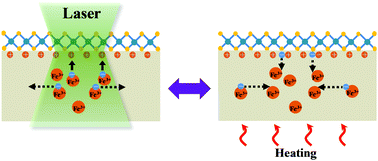Reversible photoluminescence modulation of monolayer MoS2 on a ferroelectric substrate by light irradiation and thermal annealing†
Abstract
Monolayer semiconducting two-dimensional (2D) materials are strongly emerging materials for exploring the spin-valley coupling effect and fabricating novel optoelectronic devices due to their unique structural symmetry and band structures. Due to their atomic thickness, their excitonic optical response is highly sensitive to the dielectric environment. In this work, we present a novel approach to reversibly modulate the optical properties of monolayer molybdenum disulfide (MoS2) via changing the dielectric properties of the substrate by laser irradiation and thermal annealing. We chose LiNbO3 as the substrate and recorded the PL spectra of monolayer MoS2 on LiNbO3 substrates with positive (P+) and negative (P−) ferroelectric polarities. A distinct PL intensity of the A peak was observed due to opposite doping by surface charges. Under light irradiation, the PL intensity of monolayer MoS2 on P+ Fe2O3-doped LiNbO3 gradually decreased with time due to the reduction of intrinsic p-doping, which originated from the drift of photo-excited electrons under a spontaneous polarization field and accumulation on the surface. The PL intensity was found to be restored by thermal annealing which could erase the charge redistribution. This study provides a strategy to reversibly modulate the optical properties of monolayer 2D materials on top of ferroelectric materials.

- This article is part of the themed collection: Insights into 2D Materials


 Please wait while we load your content...
Please wait while we load your content...